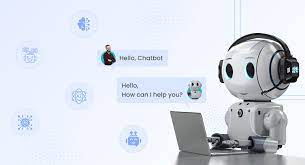
Web interface
A chatbot (originally a chatterbot) is a software application or web interface that aims to imitate human conversation through text or voice interactions. Modern chatbots are usually online and use artificial intelligence (AI) systems that are capable of maintaining a conversation with a user in natural language and simulating the way a human would behave as an interlocutor.

Recently, this field has gained widespread attention due to the popularity of OpenAI’s ChatGPT (which uses GPT-3 or GPT-4), released in 2022, followed by alternatives such as Microsoft’s Bing Chat (which uses GPT-4). OpenAI) and Bard by Google. These examples reflect the recent practice of such products being built based on broad, foundational language models that are tuned to target specific tasks or applications (i.e., simulating a human conversation, in the case of chatbots).
How chatbots work:
Early chatbots were essentially interactive FAQ programs, programmed to answer a limited set of common questions with pre-written answers. Unable to interpret natural language, they typically required users to select between simple words and phrases to move the conversation forward.
Over time, chatbot algorithms became capable of more complex rule-based programming and even natural language processing, allowing customer queries to be expressed conversationally.
- Modern AI chatbots now use natural language understanding (NLU) to discern the meaning of open user input.
- overcoming anything from typos to translation issues.
- Advanced AI tools then map that meaning to the specific “intent” the user wants the chatbot to act on.
- Use conversational AI to formulate an appropriate response.
Benefits of chatbots:
Improve customer engagement and brand loyalty:
Before the advent of chatbots, any customer question, concern, or complaint, big or small, required a human response. Naturally, sometimes timely or even urgent problems arise with clients outside of business hours, on the weekend, or during a holiday. But staffing customer service departments to meet unpredictable demand, day or night is a costly and difficult task.

Reduce costs and increase operational efficiency:
Staffing a customer service center day and night is expensive. Likewise, the time spent answering repetitive queries (and the training required to make those answers uniformly consistent) is also costly. Many foreign companies Offer to outsource these functions, but doing so carries significant costs and reduces control over a brand’s interaction with its customers.
Generate Leads and Satisfy Customers:
The web interface can help with sales lead generation and improve conversion rates. For example, a customer browsing a website looking for a product or service may have questions about different features, attributes, or plans.
A chatbot can provide these answers on the spot, helping the customer move toward purchase. For more complex purchases with a multi-step sales funnel, a chatbot can ask lead qualification questions and even connect the customer directly to a trained sales agent.
Challenges of using AI chatbots:
Despite their advantages, AI chatbots also have some drawbacks and risks. For example, they may lack the human touch and empathy to understand the customer’s emotions, tone, or intent, and may not be able to respond appropriately or empathetically. Additionally.
![16 Essential Benefits of Chatbots [+ Challenges in 2023]](https://www.tidio.com/wp-content/uploads/chatbot-challenges-700x313.png)
they may not be able to handle complex, ambiguous, or sensitive situations, such as complaints, disputes, or emergencies, and may need to escalate the issue to a human agent, which can impact customer trust, satisfaction, and loyalty. Additionally, AI chatbots may experience technical issues, such as errors, glitches, or downtime, which can disrupt service and frustrate the customer.
Solution of Challenges:
An AI chatbot solution is a software program designed to imitate human conversation by utilizing artificial intelligence (AI) and natural language processing (NLP) to comprehend and respond to customer inquiries automatically.
Leave a Reply